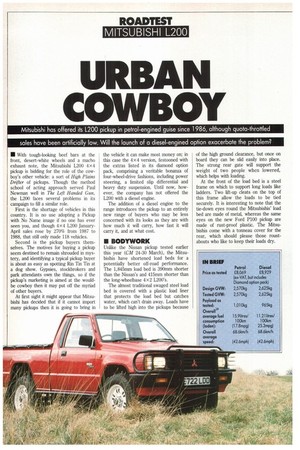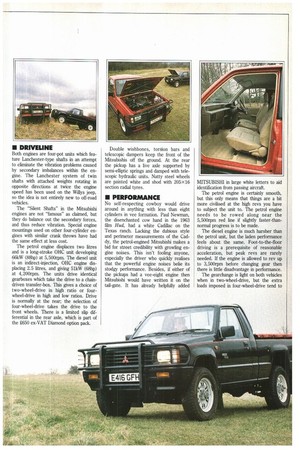URBAN COWBOY
Page 56

Page 57

If you've noticed an error in this article please click here to report it so we can fix it.
Mitsubishi has offered its L200 pickup in petrol-engined guise since 1986, although quota-throttled sales have been artificially low. Will the launch of a diesel-engined option exacerbate the problem?
• With tough-looking beef bars at the front, desert-white wheels and a macho exhaust note, the Mitsubishi L200 4x4 pickup is bidding for the role of the cowboy's other vehicle: a sort of High Plains Drifter of pickups. Though the method school of acting approach served Paul Newman well in The Left Handed Gun, the L200 faces several problems in its campaign to fill a similar role.
First is the shortage of vehicles in this country. It is no use adopting a Pickup with No Name image if no one has ever seen you, and though 4x4 L200 JanuaryApril sales rose by 270% from 1987 to 1988, that still only made 118 vehicles.
Second is the pickup buyers themselves. The motives for buying a pickup seem destined to remain shrouded in mystery, and identifying a typical pickup buyer is about as easy as spotting Rin Tin Tin at a dog show. Gypsies, stockbrokers and park attendants own the things, so if the pickup's marketing is aimed at the wouldbe cowboy then it may put off the myriad of other buyers.
At first sight it might appear that Mitsubishi has decided that if it cannot import many pickups then it is going to bring in the vehicle it can make most money on; in this case the 4x4 version, festooned with the extras listed in its diamond option pack, comprising a veritable bonanza of four-wheel-drive fashions, including power steering, a limited slip differential and heavy duty suspension. Until now, however, the company has not offered the L200 with a diesel engine.
The addition of a diesel engine to the range introduces the pickup to an entirely new range of buyers who may be less concerned with its looks as they are with how much it will carry, how fast it will carry it, and at what cost.
• BODYWORK
Unlike the Nissan pickup tested earlier this year (CM 24-30 March); the Mitsubishis have shortened load beds for a potentially better off-road performance. The 1,845nan load bed is 390mm shorter than the Nissan's and 415mm shorter than the long-wheelbase 4x2 L200's.
The almost traditional swaged steel load bed is covered with a plastic load liner that protects the load bed but catches water, which can't drain away. Loads have to be lifted high into the pickups because of the high ground clearance, but once on board they can be slid easily into place. The strong rear gate will support the weight of two people when lowered, which helps with loading.
At the front of the load bed is a steel frame on which to support long loads like ladders. Two lift-up cleats on the top of this frame allow the loads to be tied securely. It is interesting to note that the tie-down eyes round the Mitsubishis' load bed are made of metal, whereas the same eyes on the new Ford P100 pickup are made of rust-proof plastic. The Mitsubishis come with a tonneau cover for the rear, which should please those roustabouts who like to keep their loads dry.
• DR1VELINE
Both engines are four-pot units which feature Lanchester-type shafts in an attempt to eliminate the vibration problems caused by secondary imbalances within the engine. The Lanchester system of twin shafts with attached weights rotating in opposite directions at twice the engine speed has been used on the Willys jeep, so the idea is not entirely new to off-road vehicles.
The "Silent Shafts" in the Mitsubishi engines are not "famous" as claimed, but they do balance out the secondary forces, and thus reduce vibration. Special engine mountings used on other four-cylinder engines with similar crank throws have had the same effect at less cost.
The petrol engine displaces two litres and is a long-stroke OHC unit developing 66kW (88hp) at 5,500rpm. The diesel unit is an indirect-injection, OHC engine displacing 2.5 litres, and giving 5IkW (68hp) at 4,200rpm. The units drive identical gearboxes which take the drive to a chaindriven transfer-box. This gives a choice of two-wheel-drive in high ratio or fourwheel-drive in high and low ratios. Drive is normally at the rear; the selection of four-wheel-drive takes the drive to the front wheels. There is a limited slip differential in the rear axle, which is part of the £650 ex-VAT Diamond option pack. Double wishbones, torsion bars and telescopic dampers keep the front of the Mitsubishis off the ground. At the rear the pickup has a live axle supported by semi-elliptic springs and damped with telescopic hydraulic units. Natty steel wheels are painted white and shod with 205x16 section radial tyres.
• PERFORMANCE
No self-respecting cowboy would drive around in anything with less than eight cylinders in vee formation. Paul Newman, the disenchanted cow hand in the 1963 film Hud, had a white Cadillac on the Texas ranch. Lacking the dubious style and perimeter measurements of the Caddy, the petrol-engined Mitsubishi makes a bid for street credibility with growling engine noises. This isn't fooling anyone, especially the driver who quickly realises that the powerful engine noises belie its stodgy performance. Besides, if either of the pickups had a vee-eight engine then Mitsubishi would have written it on the tail-gate. It has already helpfully added MITSUBISHI in large white letters to aid identification from passing aircraft.
The petrol engine is certainly smooth, but this only means that things are a bit more civilised at the high revs you have to subject the unit to. The petrol engine needs to be rowed along near the 5,500rpm red line if slightly faster-thannormal progress is to be made.
The diesel engine is much harsher than the petrol unit, but the laden performance feels about the same. Foot-to-the-floor driving is a prerequisite of reasonable acceleration, but peak revs are rarely needed. If the engine is allowed to rev up to 3,500rpm before changing gear then there is little disadvantage in performance.
The gearchange is light on both vehicles when in two-wheel-drive, but the extra loads imposed in four-wheel-drive tend to
















































































































































